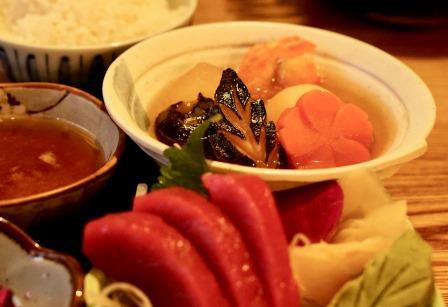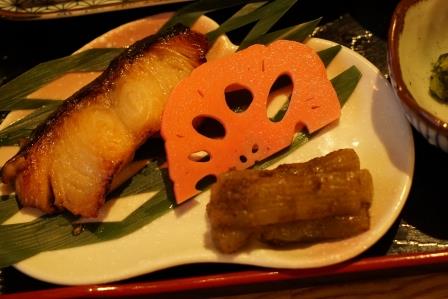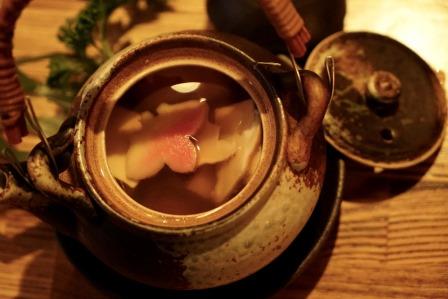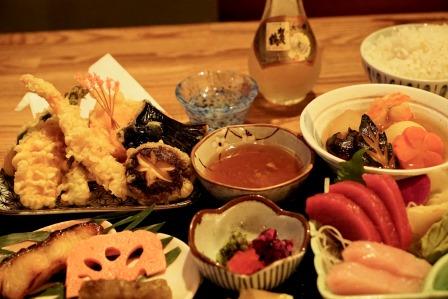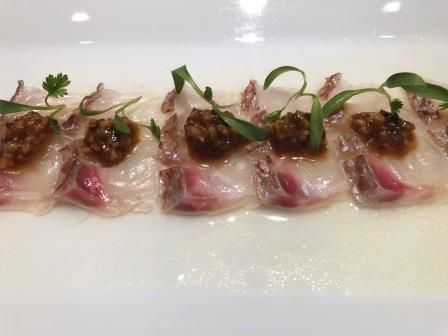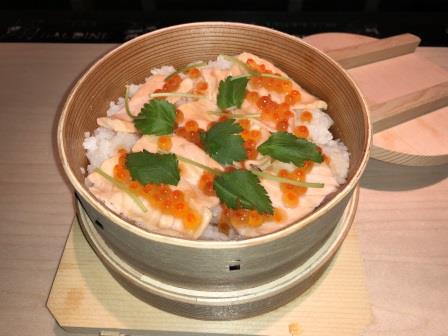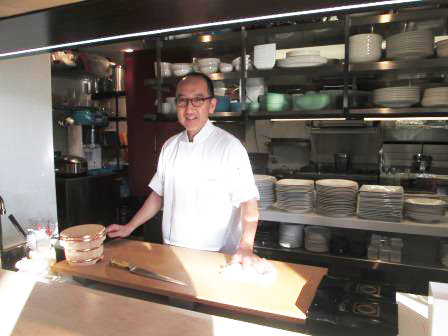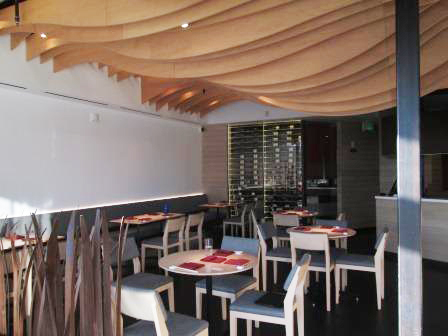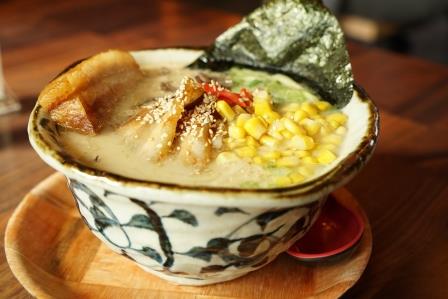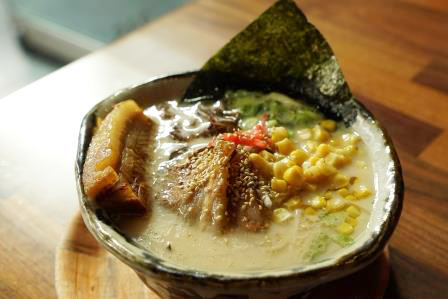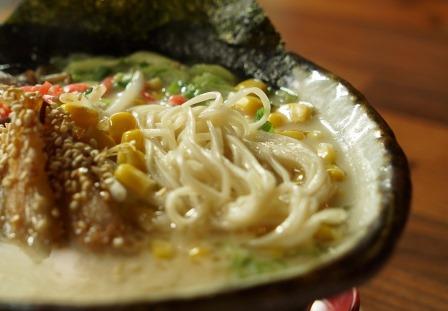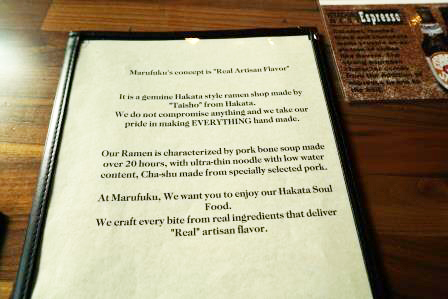A new place that carried over a legendary kappo restaurant tradition
By Elli Sekine
During the last half of the nineties in San Francisco, people were enjoying the economic growth, and traditional washoku such as high-end sushi, kappo, and kaiseki-style Japanese cuisine was beginning to gain attention. Corporate businessmen were the main target demographic, and "Kiku of Tokyo" in the Hilton Hotel, and "Kyoya" in the Palace Hotel in downtown where the convention center is located, were enjoying their popularity as the typical restaurants of that type. In the year 2000, the washoku boom entered into the fusion phase, and after 2010, the "Sushi Kaiseki" and "Omakase" era began. Now, such high-end washoku culture has settled in, and non-business people are also acquainted with the culture. Such achievements made by legendary chefs who triggered the washoku boom, are still thriving in San Francisco's restaurant industry, decades later.
In 2008, after "Kiku of Tokyo" closed, Chef Gomi opened the freestanding "Kappou Gomi" in the Richmond District, and entertained us with authentic Japanese cuisine at a reasonable price. Unlike the restaurants in the downtown hotels, there was no feel of a high-end place, private tatami rooms, etc., but Mr. Gomi seized the hearts of business people who used to know him, and of local American regular customers as well. However, finally, in October of last year, the long-lived washoku legendary restaurant in San Francisco came to an end. While everybody was reminiscing and missing the legend, Mr. Son Minh, Mr. Gomi's former favorite disciple during his "Kiku of Tokyo" days, opened "Akira", the only restaurant where his master's teachings have been inherited, and it became a popular topic of conversation.
The owner/chef, Minh was born in Vietnam. The co-owner and wife, Ms. Judy Young, was born in Laos, and came to the US as a refugee in the seventies. They met through a refugees' circle activity, and later got married. They both overcame discriminations and hardships in life. Since graduating from college, Judy has been working as a counselor for poor people and immigrants. On the other hand, Son met his master, Gomi at a washoku restaurant, "Kiku of Tokyo" where he worked as a temp while going to school. Son was working diligently, and got noticed by Chef Gomi, who told him, "If you like to cook, I can teach you how to cook washoku, starting from the basics." After the training was done, he worked as a sous-chef for a while.
After that, he worked at "Hanazen", and "Kiji" as head chef. The mater/disciple relationship between him and Mr. Gomi continued over the next 20 years, and still ongoing even now.
The name "Akira" was also given by the master. The name represents a positive and progressive approach. "Akira", which has been open for one year, is located in a residential area slightly away from Japan Town. "Akira" meets neither conditions for what a successful washoku restaurant should have, a "good location" and a "Japanese chef", but it has gotten off to a good start as if overturning such cliché. The first reason is its price setting.
Minh's transpicuous personality and diligence that shows in his words: "I would like my restaurant to be the kind of place for everyone to be able to have a reasonable meal", seem to be reflected upon how he runs the restaurant. The second reason is its menu structure. It is unbelievable for a restaurant with a mere 38 seats to have such a rich variety of items. Its line-up of popular items from the eighties such as traditional style sunomono, karaage, donburi, tempura, noodles, sashimi etc. can accommodate any customer. The third reason is the service. Every staff member is friendly, and although they are not Japanese, they have the right knowledge, and the omotenashi spirit is embedded into theirs.
While increasing the number of his original menu items, Mr. Minh always maintains traditional items as well. For example, they offer items like Shokado Bento ($17, lunch only), Chawan-mushi ($10), and Matsutake Dobin-mushi, which you don't see anywhere else. He makes dashi delicately as he has been engaging in Japanese cuisine for a long time.The fluffily strained chawan-mushi, dobinmushi with fully extracted shiitake mushrooms' flavor and umami, etc. satisfy the customers who remember "Kiku". The Shokado-Bento is one of their popular joyful lunch choices. It contains plenty of fresh sashimi, and the price is reasonable, and has become a very popular item for the Japanese people who live in a nearby residence community for Japanese Americans. At dinner time, an omakase course ($65) is offered in addition to the a-la-carte dishes. It is a kappou-style washoku course with 7 items including a small bowl of appetizer, sashimi, and fruits.
Lately, in the Bay Area of San Francisco, older Japanese owners/chefs are retiring one after another, closing the restaurants, and the generation is transitioning to non-Japanese chefs. In such a time, I can say that Mr. Minh one of the lucky ones who were able to inherit traditional Japanese cuisine techniques from a craftsman chef. I can see that a new era of washoku culture is beginning to rise at the same time while the good-old days are carried over.
割烹レジェンド店を継承する新レストラン
90年代後半、好景気に沸いていたサンフランシスコでは、寿司なら上ネタ、割烹、懐石料理といった伝統和食が注目を浴び始めていた。そのターゲットとなったのはビジネスマン達で、コンベンションホールがあるダウンタウンに位置するヒルトンホテル内の「キク オブ トウキョウ」、パレスホテル内の「京屋」はその代表店として人気を誇っていた。2000 年になると、和食ブームはフュージョン期を迎え、2010 年代に入ってからは「寿司懐石」や「オマカセ」時代となる。今やハイエンド和食は定着し、ビジネス以外の客も引き込んでいるが、その火付け役となった伝説のシェフ達が残した功績は、時代を超え今でもサンフランシスコレストラン業界に息づいている。
2008 年、「キク オブ トウキョウ」の料理長だった五味シェフは"Kiku" の 閉鎖後、リッチモンド地区に独立店舗「割烹五味」をオープンし、正統派の和食料理がリーズナブルな値段で味わえると話題を集めた。ダウンタウンのホテル内とは異なり、プレミアム感や個室の座敷などはないが、五味氏を知るビジネス客と地元アメリカ人の常連客を掴んでいた。しかしついに去年10 月、長年に及んだSF の和食伝説は幕を閉じた。誰もがその存在を惜しんでいたところ、「キク オ
ブ トウキョウ」時代、五味シェフの愛弟子だったソン・ミン氏が師からの伝授を継承する唯一の店「アキラ」がオープンした。
オーナーシェフのミン 氏はベトナム生まれ、共同オーナーで妻のジュディ・ヤング氏はラオス生まれで、70年代、難民としてアメリカに移住してきた。二人は難民サークルで出会い、やがて結婚をした。お互い差別や生活苦を乗り越え、ジュディは大学を卒業した後、現在まで貧しい人や移民のカンセリングをしている。一方ソン氏は、同時代にアルバイトをした和食レストラン、「キク オブ トウキョウ」で師匠の五味氏と出会った。真面目に働いていたソン氏に「料理が好きなら和食を基本から教えてあげよう」と声がかかった。修行後はスーシェフとして2軒の店を支えた。その後ソン氏は、「花膳」、「キジ」の料理長を勤めている。しかし五味氏との師弟関係は、20 年以上に及ぶ今でも続いている。「アキラ」という店名も師からの授かりもの。明るく漸進的な姿勢を表している。
開店から一年となる「アキラ」は、日本町からは少し離れた住宅街に位置する。成功する和食レストランの法則である「良いロケーション」と「日本人シェフ」のどちらも持ち合わせないが、それを覆すかのように幸先の良いスタートをきっている。その第一条件は価格設定だ。
「誰でもリーズナブルに食事がでる店にしたい」とソン氏の気取らない性格と勤勉さが店作りに反映されているようだ。第2 はメニュー構成にある。メニューの多さは38 席の店の規模からは想像しがたい内容だ。昔ながらの酢の物や唐揚げ、丼、天ぷら、麺類から寿司など人気アイテムの数々が並びどんな客にも対応できる。第3 にはサービスが挙げられる。スタッフは皆フレンドリーで、ノンジャパニーズでありながらも日本食の正しい知識を持ち、おもてなしの精神も継承されている。
ソン氏はオリジナルメニューを増やしながらも、伝統メニューも必ず残している。例には、松花堂弁当($17 ランチのみ)、茶碗蒸し($10)、松茸土瓶蒸しなど他店には見られないアイテムがある。日本食に長年携わったシェフらしく、出汁の取り方は繊細だ。フルフルとした茶碗蒸しのこし方やしいたけの香りと旨味を引き出した土瓶蒸しは"Kiku" を懐かしむ客を喜ばせている。松花堂弁当はランチタイムのお楽しみの一つ。新鮮な刺身も含めた盛りだくさんの内容でお値打ちとあって、近隣の日系施設に住む日本人の人気メニューとなっている。一方、夜はアラカルトの他、オマカセ($65)も提供している。小鉢からお造り、水菓子まで7品目提供する割烹風和食コースだ。
今やサンフランシスコベイエリアでは、往年の日本食オーナーシェフ達が続々リタイヤで店を閉め、ノンジャパニーズの世代へと推移している。そんな中、ソン氏は職人シェフから伝統的な日本食を受け継いだラッキーな一人かも知れない。古き良き時代を追随しながらも新しい和食時代を築き始めている。
Akira
1634 Bush Street
San Francisco, CA 94109
(415) 800-8498
http://www.akirasf.com/
Lunch
Mon.-Fri. 11:30am-2:30pm
Dinner
Mon.-Thurs. 5:00pm-10:00pm
Fri.& Sat. 5:00pm-10:30pm
During the last half of the nineties in San Francisco, people were enjoying the economic growth, and traditional washoku such as high-end sushi, kappo, and kaiseki-style Japanese cuisine was beginning to gain attention. Corporate businessmen were the main target demographic, and "Kiku of Tokyo" in the Hilton Hotel, and "Kyoya" in the Palace Hotel in downtown where the convention center is located, were enjoying their popularity as the typical restaurants of that type. In the year 2000, the washoku boom entered into the fusion phase, and after 2010, the "Sushi Kaiseki" and "Omakase" era began. Now, such high-end washoku culture has settled in, and non-business people are also acquainted with the culture. Such achievements made by legendary chefs who triggered the washoku boom, are still thriving in San Francisco's restaurant industry, decades later.
In 2008, after "Kiku of Tokyo" closed, Chef Gomi opened the freestanding "Kappou Gomi" in the Richmond District, and entertained us with authentic Japanese cuisine at a reasonable price. Unlike the restaurants in the downtown hotels, there was no feel of a high-end place, private tatami rooms, etc., but Mr. Gomi seized the hearts of business people who used to know him, and of local American regular customers as well. However, finally, in October of last year, the long-lived washoku legendary restaurant in San Francisco came to an end. While everybody was reminiscing and missing the legend, Mr. Son Minh, Mr. Gomi's former favorite disciple during his "Kiku of Tokyo" days, opened "Akira", the only restaurant where his master's teachings have been inherited, and it became a popular topic of conversation.
The owner/chef, Minh was born in Vietnam. The co-owner and wife, Ms. Judy Young, was born in Laos, and came to the US as a refugee in the seventies. They met through a refugees' circle activity, and later got married. They both overcame discriminations and hardships in life. Since graduating from college, Judy has been working as a counselor for poor people and immigrants. On the other hand, Son met his master, Gomi at a washoku restaurant, "Kiku of Tokyo" where he worked as a temp while going to school. Son was working diligently, and got noticed by Chef Gomi, who told him, "If you like to cook, I can teach you how to cook washoku, starting from the basics." After the training was done, he worked as a sous-chef for a while.
After that, he worked at "Hanazen", and "Kiji" as head chef. The mater/disciple relationship between him and Mr. Gomi continued over the next 20 years, and still ongoing even now.
The name "Akira" was also given by the master. The name represents a positive and progressive approach. "Akira", which has been open for one year, is located in a residential area slightly away from Japan Town. "Akira" meets neither conditions for what a successful washoku restaurant should have, a "good location" and a "Japanese chef", but it has gotten off to a good start as if overturning such cliché. The first reason is its price setting.
Minh's transpicuous personality and diligence that shows in his words: "I would like my restaurant to be the kind of place for everyone to be able to have a reasonable meal", seem to be reflected upon how he runs the restaurant. The second reason is its menu structure. It is unbelievable for a restaurant with a mere 38 seats to have such a rich variety of items. Its line-up of popular items from the eighties such as traditional style sunomono, karaage, donburi, tempura, noodles, sashimi etc. can accommodate any customer. The third reason is the service. Every staff member is friendly, and although they are not Japanese, they have the right knowledge, and the omotenashi spirit is embedded into theirs.
While increasing the number of his original menu items, Mr. Minh always maintains traditional items as well. For example, they offer items like Shokado Bento ($17, lunch only), Chawan-mushi ($10), and Matsutake Dobin-mushi, which you don't see anywhere else. He makes dashi delicately as he has been engaging in Japanese cuisine for a long time.The fluffily strained chawan-mushi, dobinmushi with fully extracted shiitake mushrooms' flavor and umami, etc. satisfy the customers who remember "Kiku". The Shokado-Bento is one of their popular joyful lunch choices. It contains plenty of fresh sashimi, and the price is reasonable, and has become a very popular item for the Japanese people who live in a nearby residence community for Japanese Americans. At dinner time, an omakase course ($65) is offered in addition to the a-la-carte dishes. It is a kappou-style washoku course with 7 items including a small bowl of appetizer, sashimi, and fruits.
Lately, in the Bay Area of San Francisco, older Japanese owners/chefs are retiring one after another, closing the restaurants, and the generation is transitioning to non-Japanese chefs. In such a time, I can say that Mr. Minh one of the lucky ones who were able to inherit traditional Japanese cuisine techniques from a craftsman chef. I can see that a new era of washoku culture is beginning to rise at the same time while the good-old days are carried over.
割烹レジェンド店を継承する新レストラン
90年代後半、好景気に沸いていたサンフランシスコでは、寿司なら上ネタ、割烹、懐石料理といった伝統和食が注目を浴び始めていた。そのターゲットとなったのはビジネスマン達で、コンベンションホールがあるダウンタウンに位置するヒルトンホテル内の「キク オブ トウキョウ」、パレスホテル内の「京屋」はその代表店として人気を誇っていた。2000 年になると、和食ブームはフュージョン期を迎え、2010 年代に入ってからは「寿司懐石」や「オマカセ」時代となる。今やハイエンド和食は定着し、ビジネス以外の客も引き込んでいるが、その火付け役となった伝説のシェフ達が残した功績は、時代を超え今でもサンフランシスコレストラン業界に息づいている。
2008 年、「キク オブ トウキョウ」の料理長だった五味シェフは"Kiku" の 閉鎖後、リッチモンド地区に独立店舗「割烹五味」をオープンし、正統派の和食料理がリーズナブルな値段で味わえると話題を集めた。ダウンタウンのホテル内とは異なり、プレミアム感や個室の座敷などはないが、五味氏を知るビジネス客と地元アメリカ人の常連客を掴んでいた。しかしついに去年10 月、長年に及んだSF の和食伝説は幕を閉じた。誰もがその存在を惜しんでいたところ、「キク オ
ブ トウキョウ」時代、五味シェフの愛弟子だったソン・ミン氏が師からの伝授を継承する唯一の店「アキラ」がオープンした。
オーナーシェフのミン 氏はベトナム生まれ、共同オーナーで妻のジュディ・ヤング氏はラオス生まれで、70年代、難民としてアメリカに移住してきた。二人は難民サークルで出会い、やがて結婚をした。お互い差別や生活苦を乗り越え、ジュディは大学を卒業した後、現在まで貧しい人や移民のカンセリングをしている。一方ソン氏は、同時代にアルバイトをした和食レストラン、「キク オブ トウキョウ」で師匠の五味氏と出会った。真面目に働いていたソン氏に「料理が好きなら和食を基本から教えてあげよう」と声がかかった。修行後はスーシェフとして2軒の店を支えた。その後ソン氏は、「花膳」、「キジ」の料理長を勤めている。しかし五味氏との師弟関係は、20 年以上に及ぶ今でも続いている。「アキラ」という店名も師からの授かりもの。明るく漸進的な姿勢を表している。
開店から一年となる「アキラ」は、日本町からは少し離れた住宅街に位置する。成功する和食レストランの法則である「良いロケーション」と「日本人シェフ」のどちらも持ち合わせないが、それを覆すかのように幸先の良いスタートをきっている。その第一条件は価格設定だ。
「誰でもリーズナブルに食事がでる店にしたい」とソン氏の気取らない性格と勤勉さが店作りに反映されているようだ。第2 はメニュー構成にある。メニューの多さは38 席の店の規模からは想像しがたい内容だ。昔ながらの酢の物や唐揚げ、丼、天ぷら、麺類から寿司など人気アイテムの数々が並びどんな客にも対応できる。第3 にはサービスが挙げられる。スタッフは皆フレンドリーで、ノンジャパニーズでありながらも日本食の正しい知識を持ち、おもてなしの精神も継承されている。
ソン氏はオリジナルメニューを増やしながらも、伝統メニューも必ず残している。例には、松花堂弁当($17 ランチのみ)、茶碗蒸し($10)、松茸土瓶蒸しなど他店には見られないアイテムがある。日本食に長年携わったシェフらしく、出汁の取り方は繊細だ。フルフルとした茶碗蒸しのこし方やしいたけの香りと旨味を引き出した土瓶蒸しは"Kiku" を懐かしむ客を喜ばせている。松花堂弁当はランチタイムのお楽しみの一つ。新鮮な刺身も含めた盛りだくさんの内容でお値打ちとあって、近隣の日系施設に住む日本人の人気メニューとなっている。一方、夜はアラカルトの他、オマカセ($65)も提供している。小鉢からお造り、水菓子まで7品目提供する割烹風和食コースだ。
今やサンフランシスコベイエリアでは、往年の日本食オーナーシェフ達が続々リタイヤで店を閉め、ノンジャパニーズの世代へと推移している。そんな中、ソン氏は職人シェフから伝統的な日本食を受け継いだラッキーな一人かも知れない。古き良き時代を追随しながらも新しい和食時代を築き始めている。
Akira
1634 Bush Street
San Francisco, CA 94109
(415) 800-8498
http://www.akirasf.com/
Lunch
Mon.-Fri. 11:30am-2:30pm
Dinner
Mon.-Thurs. 5:00pm-10:00pm
Fri.& Sat. 5:00pm-10:30pm








